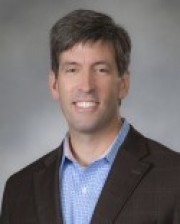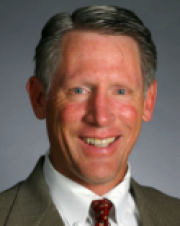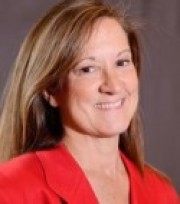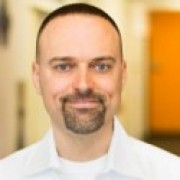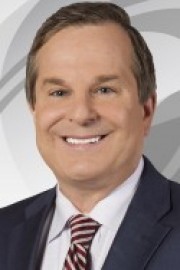Director of HS Engineering Academy
Mentor – Lane Matheson
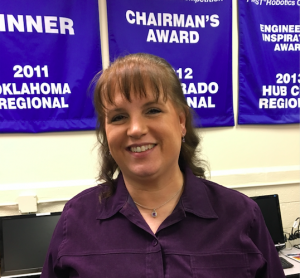 Lane heads the Tulsa Engineering Academy at Memorial High School (TEAM) where she teaches STEM courses in Science, Technology, Engineering and Mathematics along with the skills they need to succeed in life. She began teaching high school after a successful ten-year career as an aerospace engineer where she worked on the International Space Station at McDonnell Douglas. She intended on teaching for only five years and then going back to her career as an aerospace engineer. But she decided to stay after seeing the positive impact her program was having on her students. Almost all of them went on to a four-year college and graduated. Besides academic classes, Lane gives her students a chance to compete in local, regional and national engineering competitions so they apply what they have learned to practical problem solving. The Memorial robotics teams have won local and regional awards every year since 2007 and are recognized internationally to be in the top 1% of all high school robotics programs.
Lane heads the Tulsa Engineering Academy at Memorial High School (TEAM) where she teaches STEM courses in Science, Technology, Engineering and Mathematics along with the skills they need to succeed in life. She began teaching high school after a successful ten-year career as an aerospace engineer where she worked on the International Space Station at McDonnell Douglas. She intended on teaching for only five years and then going back to her career as an aerospace engineer. But she decided to stay after seeing the positive impact her program was having on her students. Almost all of them went on to a four-year college and graduated. Besides academic classes, Lane gives her students a chance to compete in local, regional and national engineering competitions so they apply what they have learned to practical problem solving. The Memorial robotics teams have won local and regional awards every year since 2007 and are recognized internationally to be in the top 1% of all high school robotics programs.
Lane grew up in the Tulsa area and graduated from Jenks High School. She received her Bachelor of Science in Mechanical engineering from Rice University and a Masters of Arts in Secondary Education from the University of Tulsa. Her many awards include being named the TPS Teacher of the Year in 2012 and the Memorial Teacher of the Year in 2011.
Lane and her husband Joe, who also teaches with her at Memorial, take a personal interest in their students and help them apply for scholarships and for admission to college engineering programs. Because their students have been so successful, their recommendations have led to most of them being given scholarships at colleges with strong engineering programs. When one girl who they thought should have been offered a scholarship was turned down, Lane and her husband paid for her scholarship themselves. That girl graduated from college with honors and is now building a successful career as an engineer. Lane and Joe continue to give financial support to other students they feel have the same kind of potential.
Lane also points out in her article that food insecurity in the Tulsa Public School system has become a problem. Over 85% of the students qualify for free breakfasts, lunches and snacks. This means that TPS now has an additional role of being one of the largest providers of nutritional programs for these children.
This article is part of a series of YPNG.co articles on STEM careers, which offer the highest salaries of all college majors and give students many different career paths after graduation. Engineering in particular is a career where there is a shortage of qualified people and consequently many opportunities for scholarships.
My Career Path
I got interested in Star Trek between the sixth and seventh grade and that interest gave me a desire to work in aerospace. While I knew I would have to work really hard to achieve my goal, I was not exactly sure how I wanted to be involved in the space industry. I first dug into being an astronaut but soon realized that I probably would not qualify from a physical standpoint. So I started looking for other avenues. I took the Armed Services Vocational Aptitude Battery (ASVAB) and the results indicated that I would be good at mechanical engineering. I also took an engineering aptitude test in eleventh grade that put me in the top twelve percent of twelfth grade boys for mechanical engineering. There was only data on boys back in 1978 because so few women were going into the profession.
I made a point of taking all the math and science that Jenks High School offered in order to prepare myself for college engineering classes. I was not sure where I wanted to go to college, but I had placed Rice on my list. After I became a National Merritt Scholar, Rice offed me a scholarship. But it didn’t pay for everything. I had a full ride at the University of Oklahoma and talked with my Dad. He operated his own business and wanted to make sure that I had good values when it came to money. Our understanding was that I would work through the summer to help pay for college costs.
I spent four years at Rice, graduated with honors and then went out to find a company where I could work in a space program. I interviewed with McDonnell Douglas in the fall of my senior year and got a rejection letter because I wasn’t graduating in December. But they called me five months later right before I graduated and said they were looking for engineers who had exposure to different engineering disciplines. Rice had provided me that. I had training in electrical and chemical and had emphasized aerospace. The International Space Station program was just getting off the ground at that time and McDonald Douglas was looking at how they were going to respond to the requests for proposals from NASA. I said that if I was going to accept a position, the space station program was the part of the company where I wanted to work. Fortunately they gave me a job as a systems engineer in that program. I moved to California and started working on the space station doing things nobody had ever done.
There were no desktop computers in 1984. Instead, we were working on a mainframe using terminals. Apple came out with their desktop a couple years later and I was the only person who knew how to do 3D drawing on that computer. Up until that time, engineering drawings were done on a drafting table. By the time I left ten years later, all the company’s engineering drawings were being done on a computer. Now 3D modeling is something I teach my high school students. 3D modeling was an important tool for us. You could not build the space station and put the pieces together on the ground to see how they fit because they were designed to be in orbit where there is no gravity. So all the testing had to be done using 3D modeling.
While I worked on several different aspects of the space station with other people, I worked on a team that designed the trunnion pins used to mount the parts of the space station in the cargo bay on the Space Shuttle. Up to that point, every team that was designing part of the space station designed their own pins so there was no commonality. This was getting very expensive because each set had to be manufactured separately. Our design worked for all these different parts and was meant to use the minimum number or pins necessary to save money and not have a significant impact on launch weight.
After working ten years at McDonnell Douglas, I decided that I would come back to Tulsa and teach for five years and then look for a job in a new space program. Before I started teaching, I went to the University of Tulsa and got my Masters in Secondary Education in 1996 and then started teaching at Memorial. I proposed to the principal that I teach a high school exposure class in engineering that he thought was an awesome idea. The kids loved it. In 2002, I tried to get the students involved in a robotics program. But we just didn’t get anywhere that first year and I approached another teacher, Joe Matheson, who was head of the science department at the time to help me get the team started. We went to a conference and found out about the robotics competition, brought all the stuff back, got the team started and ended up getting married at the end of the year.
The TEAM Program
Memorial has been the magnet school for engineering for the Tulsa Public School system since 2005. The criteria we have for admission to the program are primarily based on a student’s grades. But I think it is almost more important that the students have the desire and heart to pursue this type of education. I can spark that fire in most students once they are here.
We have more openings for students than just the ones we accept. I think that is because we are not that well known so we get fewer applicants. But we tend to produce more graduates than the other programs that have gotten some of the larger federal and foundation grants. Because I have to administer the TEAM program and teach, I don’t have a lot of time to go out and write grant applications that require a lot of budget and accounting detail.
Right now all the kids that are finishing their four years in our TEAM program are those who went into robotics where they are able to see what they learn in the classroom applied to real world problem solving. I think this kind of project-based learning is the most effective way to teach engineering to high school students. When I was doing my own curriculum, I was bringing in a lot of projects that taught my students the problem solving aspect of engineering based on their interests beginning with the freshman class. For example, around Halloween I would do what was called super pumpkin landing aeronautic technology or SPLAT where the kids would have to build something that would keep a pumpkin from cracking when it was dropped off the back of the football stadium. We also had them come up with a way to sell the device to a theoretical buyer. So we taught them not just how to design a device and build it but also how to take it through the next steps of commercialization. If you are going to be an innovator, you also need to have a little business savvy.
Robotics Competition
We compete in the FIRST robotics competitions. FIRST stands for “For Inspiration and Recognition of Science and Technology and is the leading, not-for-profit STEM engagement program for kids worldwide. Competitions begin at the regional level. Regional winners then advance to national and international competition. Before the robotics competition, the students are given a list of what a theoretical buyer might want. For example, they might specify the robot has to be able to go through certain defenses and able to shoot a ball either high or low. The customer also specifies what the robot cannot do. We also have the students ask themselves what the customer is silent on so we can find ways to be creative in developing our solution.
The robotics team has just six weeks to build the robot and get it ready to go to competition. At the same time we are building the robot, we are writing essays for award presentations and developing our presentation for the judges where three people talk about community outreach and another group talks about our safety program. The six-week schedule also teaches the students that they have to be able to plan and meet deadlines. At the end of the six weeks, you have to put your robot in a big plastic bag and seal it before the competition, take a picture and certify that is was sealed on time.
I have brought in Junior Achievement with my robotics team so the kids can understand the concept of starting their own business. Part of this is a weekly professional dress day where the kids come in with their suits. We also push all of our kids to be able to speak to any judges who come around during the competition and tell our kids they have to be ready to respond. You can watch them go from shy kids who stand in the back of the room to being out front and finding out they can be dynamic leaders who have all these great ideas they want to make happen.
We started the robotics team in 2002 and by 2007 we had won our first regional competition and have continued to win championships at different levels every year for the past ten years. Our success has given us an international reputation. Our awards place us in the top 1% of the over 5,000 robotics teams in the world.
Here is a link to the our final (winning) match in 2015 when we won Robot, Chairman’s Award, and Engineering Inspiration – the top three awards that FIRST gives.
https://www.thebluealliance.com/match/2015okok_f1m3
We have a strong booster club for our robotics team and we raise a significant amount of money second only to the money raised by the football program. We put our sponsors on our banners, our robots and our demonstration pit to give our sponsors recognition.
This is a picture of me and my husband standing in front of some of the award banners our teams have won:
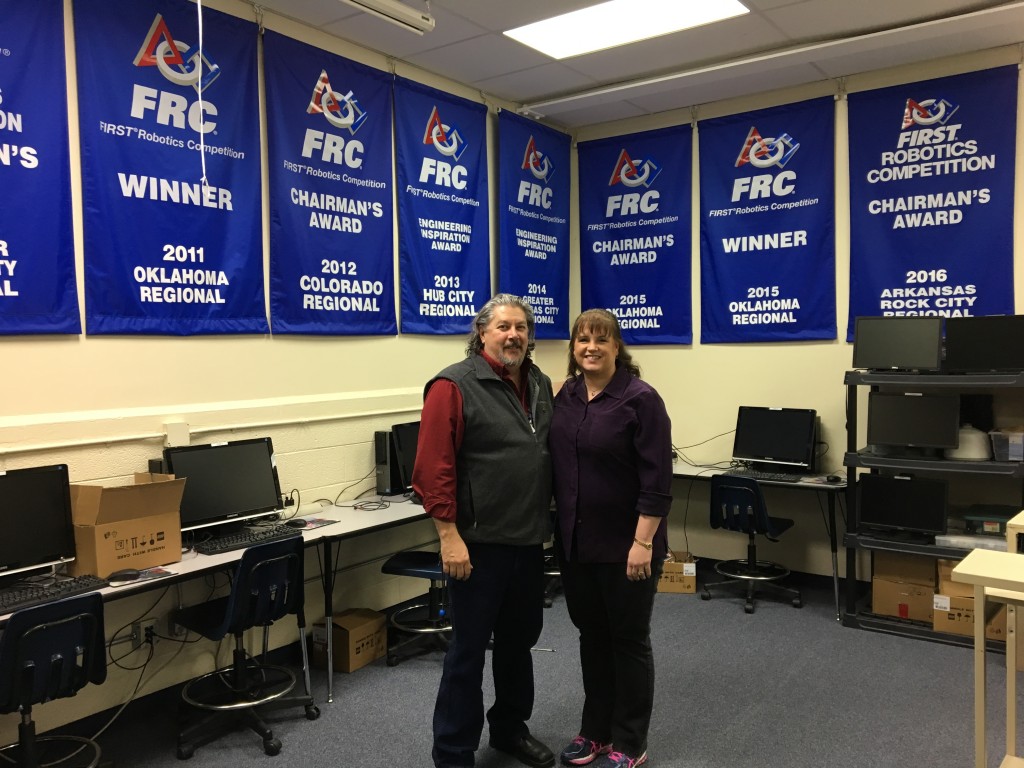
How to Prepare for a College Engineering Program
The absolute most important thing is to take all the math you can at your high school. I have my students double up and take either geometry with Algebra II or geometry with pre calculus so they can get to both levels of calculus before they graduate.
Here is a typical sequence of all courses for science, technology, engineering, and math in our TEAM program:
9th Grade:
Introduction to Engineering Design, Pre-AP Biology, & Pre-AP Algebra II*
*Students may enroll in Pre-AP Algebra I in 9th grade with prior approval.
10th Grade:
AP Physics 1, Pre-AP Geometry, Pre-Calculus, Principles of Engineering
11th Grade:
AP Physics 2, Pre-AP Chemistry, AP Calculus AB
12th Grade:
AP Calculus BC; Choose 1 or more: AP Physics C, AP Chemistry, AP Biology, AP Environmental Science, AP Statistics, Anatomy & Physiology, Zoology/Botany
TEAM students may substitute Engineering Robotics for Principles of Engineering.
Engineering Robotics is an elective class. Students do not have to be enrolled in Engineering Robotics to participate on the Robotics Team as an extracurricular activity.
TEAM requires a minimum of two years of foreign language in addition to all other TPS graduation requirements to prepare students for a global career.
Scholarships
Right now all my kids that are planning on going to four-year colleges have scholarships. Here is what you need to do so you too can be successful when you apply for scholarships:
- Getting good grades in high school in your core courses is important for getting STEM college scholarships. If you are on a five-point scale, then you should be at least above a four point.
- It is also important to take classes to help you with standardized college entrance exams like the ACT. You need both good high school grades and good test scores to get the best scholarships
- The University of Tulsa offers engineering scholarships to high school graduates in the Tulsa area. This is an excellent way to get a degree at a university with a well-recognized engineering program.
- Ask your teachers to write a recommendation for a scholarship for you. I have been very successful in writing personal recommendations that have resulted in my students getting scholarships. I had one girl who got into TU on the strength of my recommendation who only had a 20 ACT. She was a good student but unfortunately did not perform well on the test. The universities are starting to understand standardized tests are not the predictors they are supposed to be especially for women and minorities. I had another girl who was turned down for the Tulsa Engineering scholarship because she had a low ACT score and she blew through mechanical engineering at OU. My husband and I gave her a scholarship out of our own pocket to get her there and we have done the same with a few other students over the years. I can only recommend five students a year and I only recommend the ones I know have the abilities to make it after seeing them in my classes for four years.
Food Insecurity in TPS
The Tulsa Public School system is taking on another role besides just education. For many years, Memorial was a middle-income school district with a good property tax base like many suburban schools. But over the last twenty years the income level of people in the Memorial school district has dropped. Now over 80% of the Memorial kids and over 85% of all TPS students qualify for reduced breakfasts and lunches and are given food bags for over the weekend. Our counselors are begging people to donate food for our kids who are hungry. We have parents who provide food for kids during our Robotics sessions and on Saturdays and when we are here all day on Saturdays. But TPS can use more help with food donations.
US Bureau of Labor Statistics for Engineers
The median annual wage of all engineers in 2015 was $95,900. The top ten percent earned more than $150,800 and the bottom ten percent earned $52,010.
Some of the highest paying careers in the world are found in engineering. Engineering is widely considered as one of the most lucrative and in demand career choices, with multiple engineering disciplines and job types, as well as salaries that can exceed $100k per year once the engineer has some experience behind them¹. Engineers tend to earn in excess of the national average salary and this is expected by some reputable organizations to continue in the future¹. In fact, Engineering degrees make up 10 of the top 17 highest paid degrees at the time of this survey in 2015.




